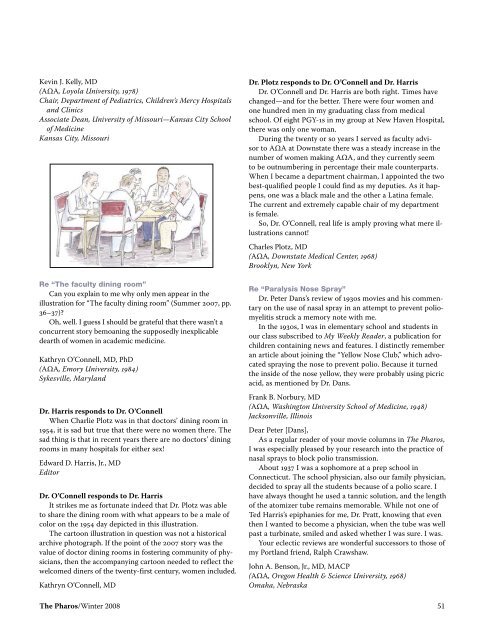Download The Pharos Winter 2008 Edition - Alpha Omega Alpha
Download The Pharos Winter 2008 Edition - Alpha Omega Alpha
Download The Pharos Winter 2008 Edition - Alpha Omega Alpha
Create successful ePaper yourself
Turn your PDF publications into a flip-book with our unique Google optimized e-Paper software.
Kevin J. Kelly, MD<br />
(AΩA, Loyola University, 1978)<br />
Chair, Department of Pediatrics, Children’s Mercy Hospitals<br />
and Clinics<br />
Associate Dean, University of Missouri—Kansas City School<br />
of Medicine<br />
Kansas City, Missouri<br />
Re “<strong>The</strong> faculty dining room”<br />
Can you explain to me why only men appear in the<br />
illustration for “<strong>The</strong> faculty dining room” (Summer 2007, pp.<br />
36–37)?<br />
Oh, well. I guess I should be grateful that there wasn’t a<br />
concurrent story bemoaning the supposedly inexplicable<br />
dearth of women in academic medicine.<br />
Kathryn O’Connell, MD, PhD<br />
(AΩA, Emory University, 1984)<br />
Sykesville, Maryland<br />
Dr. Harris responds to Dr. O’Connell<br />
When Charlie Plotz was in that doctors’ dining room in<br />
1954, it is sad but true that there were no women there. <strong>The</strong><br />
sad thing is that in recent years there are no doctors’ dining<br />
rooms in many hospitals for either sex!<br />
Edward D. Harris, Jr., MD<br />
Editor<br />
Dr. O’Connell responds to Dr. Harris<br />
It strikes me as fortunate indeed that Dr. Plotz was able<br />
to share the dining room with what appears to be a male of<br />
color on the 1954 day depicted in this illustration.<br />
<strong>The</strong> cartoon illustration in question was not a historical<br />
archive photograph. If the point of the 2007 story was the<br />
value of doctor dining rooms in fostering community of physicians,<br />
then the accompanying cartoon needed to reflect the<br />
welcomed diners of the twenty-first century, women included.<br />
Kathryn O’Connell, MD<br />
Dr. Plotz responds to Dr. O’Connell and Dr. Harris<br />
Dr. O’Connell and Dr. Harris are both right. Times have<br />
changed—and for the better. <strong>The</strong>re were four women and<br />
one hundred men in my graduating class from medical<br />
school. Of eight PGY-1s in my group at New Haven Hospital,<br />
there was only one woman.<br />
During the twenty or so years I served as faculty advisor<br />
to AΩA at Downstate there was a steady increase in the<br />
number of women making AΩA, and they currently seem<br />
to be outnumbering in percentage their male counterparts.<br />
When I became a department chairman, I appointed the two<br />
best- qualified people I could find as my deputies. As it happens,<br />
one was a black male and the other a Latina female.<br />
<strong>The</strong> current and extremely capable chair of my department<br />
is female.<br />
So, Dr. O’Connell, real life is amply proving what mere illustrations<br />
cannot!<br />
Charles Plotz, MD<br />
(AΩA, Downstate Medical Center, 1968)<br />
Brooklyn, New York<br />
Re “Paralysis Nose Spray”<br />
Dr. Peter Dans’s review of 1930s movies and his commentary<br />
on the use of nasal spray in an attempt to prevent poliomyelitis<br />
struck a memory note with me.<br />
In the 1930s, I was in elementary school and students in<br />
our class subscribed to My Weekly Reader, a publication for<br />
children containing news and features. I distinctly remember<br />
an article about joining the “Yellow Nose Club,” which advocated<br />
spraying the nose to prevent polio. Because it turned<br />
the inside of the nose yellow, they were probably using picric<br />
acid, as mentioned by Dr. Dans.<br />
Frank B. Norbury, MD<br />
(AΩA, Washington University School of Medicine, 1948)<br />
Jacksonville, Illinois<br />
Dear Peter [Dans],<br />
As a regular reader of your movie columns in <strong>The</strong> <strong>Pharos</strong>,<br />
I was especially pleased by your research into the practice of<br />
nasal sprays to block polio transmission.<br />
About 1937 I was a sophomore at a prep school in<br />
Connecticut. <strong>The</strong> school physician, also our family physician,<br />
decided to spray all the students because of a polio scare. I<br />
have always thought he used a tannic solution, and the length<br />
of the atomizer tube remains memorable. While not one of<br />
Ted Harris’s epiphanies for me, Dr. Pratt, knowing that even<br />
then I wanted to become a physician, when the tube was well<br />
past a turbinate, smiled and asked whether I was sure. I was.<br />
Your eclectic reviews are wonderful successors to those of<br />
my Portland friend, Ralph Crawshaw.<br />
John A. Benson, Jr., MD, MACP<br />
(AΩA, Oregon Health & Science University, 1968)<br />
Omaha, Nebraska<br />
<strong>The</strong> <strong>Pharos</strong>/<strong>Winter</strong> <strong>2008</strong> 51














